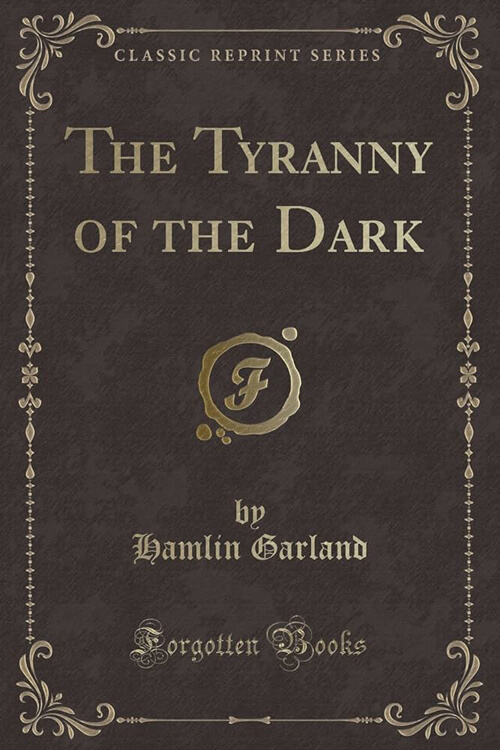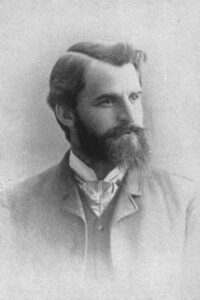
The Tyranny of the Dark
The village of Colorow is enclosed by a colossal amphitheater of dove-gray stone, in whose niches wind-warped pines stand like spectators silent and waiting. Six thousand feet above the valley floor green and orange slopes run to the edges of perennial ice fields, while farther away, and peering above these almost inaccessible defenses, like tents of besieging Titans, rise three great mountains gleaming with snow and thunderous with storms. Altogether a stage worthy of some colossal drama rather than the calm slumber of a forgotten hamlet.
The railway enters the valley from the south by sinuously following the windings of a rushing, foam-white stream, and for many miles the engines cautiously feel their way among stupendous walls, passing haltingly over bridges hung perilously between perpendicular cliffs by slender iron rods, or creep like mountain-cats from ledge to ledge, so that when they have reached safe harbor beside the little red depot they never fail to pant and wheeze like a tired, gratified dog beside his master’s door. Aside from the coming and going of these trains, the town is as silent as the pines.
The only other ways of entrance to this deep pocket lie over threadlike trails that climb the divide from Silver City and Toltec and Vermilion, and loop their terrifying courses down the declivities trod only by the sturdy burro or the agile, sure-footed mountain-horse. These wavering paths, worn deep and dusty once, are grass-grown now, for they were built in the days when silver was accounted a precious metal, and only an occasional hunter or prospector makes present use of them.
Colorow itself, once a flaming, tumultuous center of miners, gamblers, and social outcasts, has now risen (or declined) to the quiet of a New England summer resort, supported partly by two or three big mines (whose white ore is streaked with gold), but more and more by the growing fame of its mountains and their medicinal springs, for these splendid peaks have their waters, hot and cold and sweet and bitter, whose healing powers are becoming known to an ever-growing number of those Americans who are minded to explore their native land.
This center of aërial storms, these groups of transcendent summits, would be more widely known still, but for the singular sense of proprietorship with which each discoverer regards them. The lucky traveler who falls into this paradise is seized with a certain instant jealousy of it and communicates his knowledge only to his family and his friends. Nevertheless, its fame spreads slowly, and each year new discoverers flock in growing numbers to the one little hotel and its ramshackle bath-house, so that the community once absolutely and viciously utilitarian begins to take timid account of its aesthetic surroundings, and here and there a little log-cabin (as appropriate to this land as the chalet to the Alps) is built beside the calling ripples of the river, while saddled horses, laden burros in long lines, and now and then a vast yellow or red ore-wagon creaking dolefully as it descends, still give evidence of the mining which goes on far up the zigzag trails towards the soaring, shining peaks of the Continental Divide.
Read or download Book
Hamlin Garland
Hannibal Hamlin Garland (September 14, 1860 – March 4, 1940) was an American novelist, poet, essayist, short story writer, Georgist, and psychical researcher. He is best known for his fiction involving hard-working Midwestern farmers.
Biography
Hannibal Hamlin Garland was born on a farm near West Salem, Wisconsin, on September 14, 1860, the second of four children of Richard Garland of Maine and Charlotte Isabelle McClintock. The boy was named after Hannibal Hamlin, the vice president under Abraham Lincoln. He lived on various Midwestern farms throughout his young life, but settled in Boston, Massachusetts, in 1884 to pursue a career in writing.
He read diligently in the Boston Public Library. There he became enamored with the ideas of Henry George, and his Single Tax Movement. George’s ideas came to influence a number of his works, such as Main-Travelled Roads (1891), Prairie Folks (1892), and his novel Jason Edwards (1892).
Main-Travelled Roads was his first major success. It was a collection of short stories inspired by his days on the farm. He serialized a biography of Ulysses S. Grant in McClure’s Magazine before publishing it as a book in 1898. The same year, Garland traveled to the Yukon to witness the Klondike Gold Rush, which inspired The Trail of the Gold Seekers (1899). He lived on a farm between Osage, and St. Ansgar, Iowa for quite some time. Many of his writings are based on this era of his life.
In 1893, Hamlin moved to Chicago, where he lived at 6427 South Greenwood Avenue in the Woodlawn neighborhood. He is considered “a significant figure in the Chicago Literary Movement” and “one of Chicago’s most important authors”. Moccasin Ranch Park, located near the address, is named in his honor.
In Illinois, Garland married Zulime Taft, the sister of sculptor Lorado Taft, and began working as a teacher and a lecturer.
A prolific writer, Garland continued to publish novels, short fiction, and essays. In 1917, he published his autobiography, A Son of the Middle Border. The book’s success prompted a sequel, A Daughter of the Middle Border, for which Garland won the 1922 Pulitzer Prize for Biography. After two more volumes, Garland began a second series of memoirs based on his diary. Garland became quite well-known during his lifetime and had many friends in literary circles. He was made a member of the American Academy of Arts and Letters in 1918.
After moving to Hollywood, California, in 1929, he devoted his remaining years to investigating psychic phenomena, an enthusiasm he first undertook in 1891. In his final book, The Mystery of the Buried Crosses (1939), he tried to defend such phenomena and prove the legitimacy of psychic mediums.
A friend, Lee Shippey, columnist for the Los Angeles Times, recalled Garland’s regular system of writing:
. . . he got up at half past five, brewed a pot of coffee made toast on an electric gadget in his study, and was at work by six. At nine o’clock he was through with work for the day. Then he breakfasted, read the morning paper, and attended to his mail. . . . After luncheon he and Mrs. Garland would take a long drive . . . . Sometimes they would drop in on Will Rogers, Will Durant, Robert Benchley, or even on me, for their range of friends was very wide. . . . After dinner they would go to a show if an exceptionally good one were in town, otherwise one of their daughters would read aloud.






